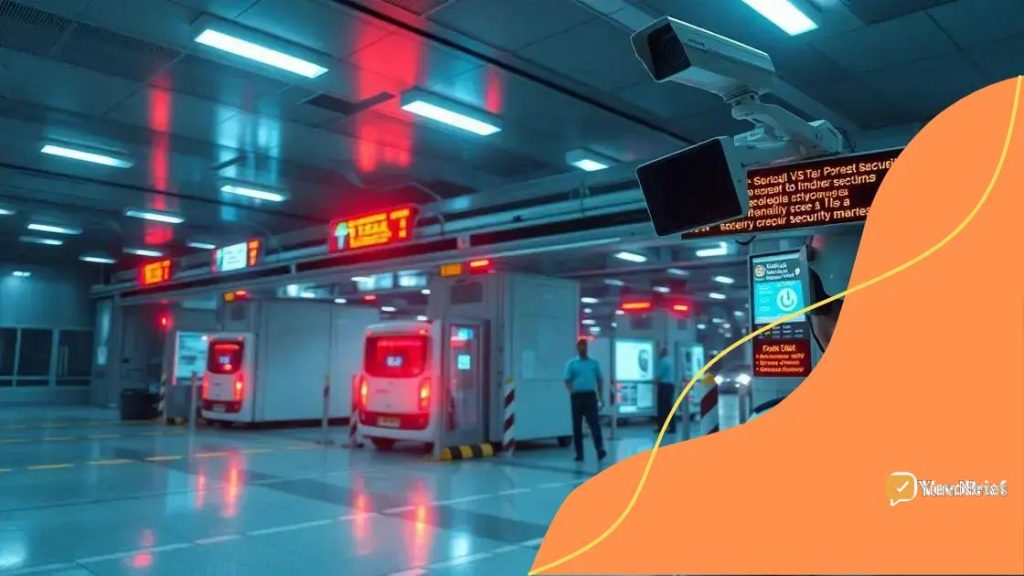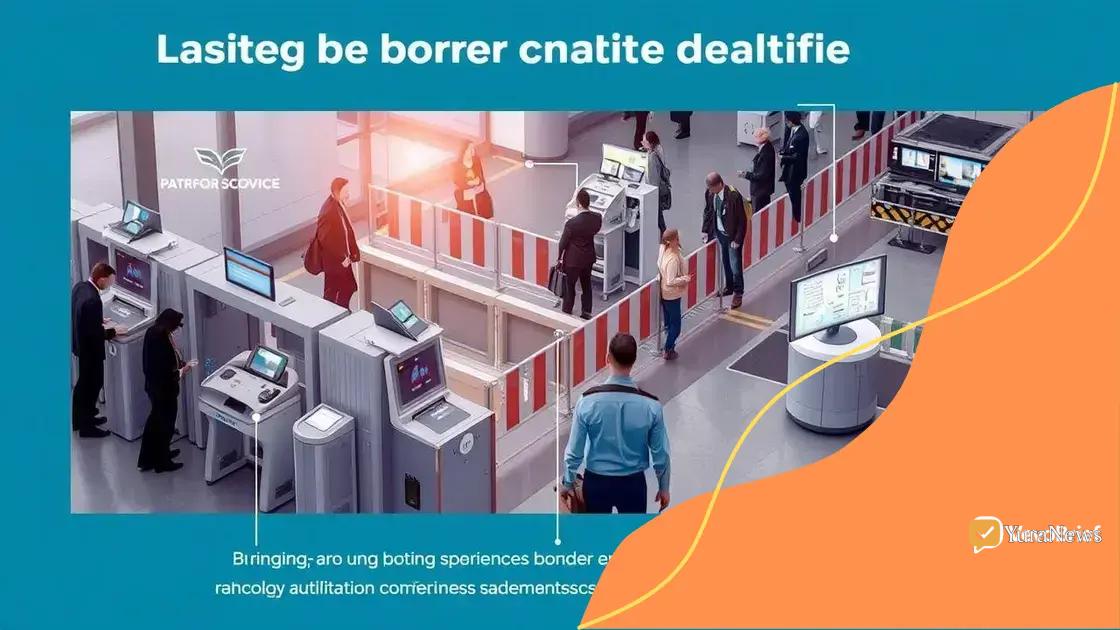Administration unveils new border security technology

Anúncios
The administration unveils new border security technology that utilizes AI, biometric systems, and automated surveillance to enhance safety and efficiency at border crossings while addressing implementation challenges.
Administration unveils new border security technology that promises to change the game in enhancing security measures. Curious about how this might impact travel and safety? Let’s dive into the specifics.
Anúncios
Understanding the new border security technology
Understanding the new border security technology can be fascinating and crucial for all of us. This technology is designed to enhance safety and streamline processes at borders. By focusing on key developments, we can better appreciate how it impacts our daily lives.
Key Components of the Technology
This new border security technology incorporates various advanced features that aim to improve efficiency. Some components include:
- Biometric Identification: Systems that use facial recognition and fingerprint scanning for accurate identification.
- Automated Surveillance: Drones and cameras that monitor borders in real-time.
- Data Analytics: Advanced algorithms analyze patterns to predict and respond to potential threats.
The integration of these technologies is not just a leap forward; it also represents a shift in how we view safety and security. With ongoing advancements, authorities can manage borders with increased precision and effectiveness.
Anúncios
Benefits of New Technology
There are numerous benefits associated with implementing this innovative technology.
- Increased Safety: Enhanced monitoring capabilities help reduce illegal crossings and security threats.
- Efficient Processing: Faster identification and processing reduce waiting times at border checkpoints.
- Resource Allocation: Improved data analysis allows for more effective deployment of personnel and resources.
As we embrace these advancements, it becomes clear that technology plays a vital role in shaping a safer environment. The continuous evolution of technology promises even more robust solutions in the future.
As we continue to adapt to new challenges, understanding how this technology functions is essential. It not only keeps borders secure but also ensures a smoother experience for travelers. The potential is vast, and the implications are significant, highlighting the importance of advancements in border security.
Key features of the latest advancements
The key features of the latest advancements in border security technology are truly remarkable. By harnessing cutting-edge innovations, these features aim to improve safety and streamline operations. Understanding these features can help us recognize the significance of these advancements.
Advanced Biometric Systems
One of the pivotal components is the use of advanced biometric systems. These systems offer:
- Facial Recognition: Enables fast and accurate identification of individuals at border crossings.
- Fingerprint Scanning: Provides an additional layer of security by verifying identities with high precision.
- Retina Scanning: A unique method that enhances identification accuracy and deters identity fraud.
Biometric systems not only increase safety but also speed up processing times, making travel easier for everyone.
Automated Surveillance Technology
Another significant advancement lies in automated surveillance technology, which transforms how we monitor borders. This technology incorporates:
- High-definition Cameras: Capable of providing clear images for better assessment and response to incidents.
- Drone Surveillance: Offers aerial perspectives, allowing for broader coverage of border areas.
- Motion Sensors: Detect unauthorized activities in real-time, enhancing prompt responses.
Utilizing these tools creates a more proactive approach to border security.
Furthermore, the integration of these key features fosters better collaboration among security agencies. By sharing data and insights, authorities can quickly adapt to developing situations. This collaboration ultimately strengthens our collective safety and improves border management.
As the landscape of safety evolves, the introduction of these advanced systems showcases a commitment to leveraging technology for a secure future. Expecting continuous improvements, border security will significantly benefit from these latest advancements.
Impact on border control and safety

The impact of new technologies on border control and safety is profound. These innovations not only enhance security but also streamline operations. Understanding these effects helps us appreciate how they transform border management.
Improved Surveillance Capabilities
One significant impact of new technology is the enhancement of surveillance capabilities. With systems that include:
- Real-time Monitoring: Authorities can observe border activities 24/7, ensuring prompt responses to any suspicious behavior.
- High-resolution Imaging: New cameras provide clearer images, allowing for accurate identification and assessment of potential threats.
- Embedded Sensors: These devices alert officials about possible breaches in real-time, supporting rapid intervention.
These advancements lead to more effective and proactive management of border security.
Increased Efficiency in Processing
Technological improvements also lead to more efficient processing of individuals crossing borders. With automated systems, travelers experience:
- Faster Check-ins: Automated kiosks speed up the identification process, reducing long wait times.
- Streamlined Data Collection: Information is gathered securely and efficiently, often with minimal human intervention.
- Enhanced Passenger Experience: This technology results in more satisfied travelers, as the crossing experience becomes smoother.
Ultimately, a more efficient process benefits both travelers and security personnel.
Furthermore, by leveraging technology for border control, authorities can allocate resources more effectively. This leads to a better balance between safety and accessibility. Travelers can enjoy seamless experiences while also feeling secure, showcasing a modern approach to border management.
As we navigate towards a tech-driven future, it is vital to recognize the transformative effects that advanced border security technology brings to safety and control. The focus on leveraging modern tools continues to shape how we understand borders and national security.
Challenges in implementation and operation
The challenges in implementation and operation of new border security technologies are significant. While these advancements offer numerous benefits, addressing the hurdles they present is crucial for effective integration and functioning.
Technical Integration Issues
One of the primary challenges is the integration of various systems. Different technologies may not communicate well with each other, leading to:
- Data Compatibility Issues: Different formats and standards can cause problems in data sharing across platforms.
- Training Needs: Personnel must adapt to new systems, requiring time and resources for effective training.
- Maintenance Challenges: Keeping all systems updated and functioning properly can be resource-intensive.
Addressing these issues is essential for realizing the full potential of new technologies.
Budget and Resource Constraints
Financial limitations pose another barrier in adopting advanced security measures. Governments may face:
- High Initial Costs: Implementing new technology often requires significant upfront investments, which can strain budgets.
- Ongoing Costs: Maintenance, updates, and training add to the long-term financial commitment.
- Resource Allocation: Competing priorities can make it difficult to allocate necessary funding to border security improvements.
Finding ways to manage these financial challenges is critical for successful implementation.
Moreover, public perception plays a vital role in how these technologies are adopted. Ensuring the community feels secure and informed can help foster support for new measures. Engaging with the public and addressing concerns contributes to a smoother integration process.
As we continue to push the boundaries of security technology, addressing these challenges heads-on will be vital for not only enhancing border security but also ensuring community trust and operational efficiency.
Future prospects of border security technologies
The future prospects of border security technologies are exciting and full of potential. As innovation continues, we can expect significant advancements that will enhance safety and efficiency at borders.
Emerging Technologies
New technologies are on the horizon that can revolutionize border security. These include:
- Artificial Intelligence (AI): AI can analyze vast amounts of data to identify patterns and threats more effectively.
- Blockchain Technology: This technology can improve data security and transparency for cross-border transactions.
- Internet of Things (IoT): IoT devices can provide real-time monitoring and alerts, significantly improving response times.
Integrating these technologies will provide authorities with better tools to manage border security.
Enhanced Collaboration
Future advancements will likely see improved collaboration between countries and agencies. Sharing intelligence and resources fosters a unified approach to security. This includes:
- Joint Training Programs: Improved coordination can lead to effective training for border patrol agents.
- Information Sharing Platforms: These systems can allow different nations to share data securely.
- Collaborative Research: Working together on new technologies can expedite advancements and best practices.
As nations work together, they can enhance their overall security posture.
Furthermore, public acceptance and engagement will play a crucial role in the adoption of these technologies. Ensuring that communities feel informed and safe will foster a positive environment for introducing innovations. Continuous communication and transparency with the public can build trust and support for new measures.
As we look ahead, the prospects for border security technologies promise to enhance national security while making travel safer for everyone. The commitment to innovation and collaboration will shape a brighter future for border management.
FAQ – Frequently Asked Questions about Border Security Technology
What technologies are being used in border security today?
Current technologies include biometric systems, AI, and automated surveillance to enhance security and efficiency at border crossings.
What challenges does the implementation of new border security technologies face?
Implementation challenges include high costs, technical integration issues, and the need for training personnel to effectively use new systems.
How can countries collaborate to improve border security?
Countries can collaborate by sharing intelligence, conducting joint training programs, and developing information-sharing platforms.
Why is public engagement important in implementing border security measures?
Public engagement fosters trust and support, ensuring communities understand and feel secure about the technologies being implemented.